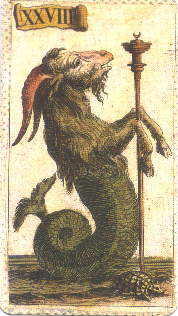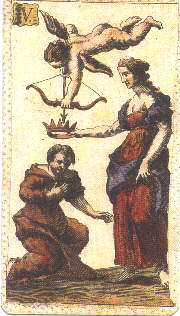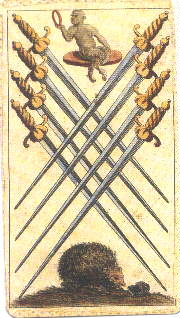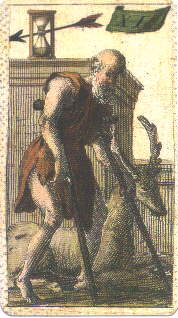|
Navigation |
Ancient Minchiate Etruria
Minchiate is a variant form of tarot, popular in Florence for many centuries. A Minchiate deck differs from a standard tarot deck by having an extended series of 41 trumps, making 97 cards in the entire deck. The additional cards are the twelve signs of the zodiac, the four elements (earth, water, air, and fire), and the virtues Prudence, Faith, Hope, and Charity, who join their sisters Justice, Strength, and Temperance from the standard tarot. There is also a variation in the first few trumps: Papess, Empress, Emperor, and Pope are replaced by the three cards Grand Duke, Western Emperor, and Eastern Emperor. (The Papess and Pope often attracted ecclesiastical disapproval and were replaced with more "acceptable" variants.)
This particular deck is the most beautifully drawn of the various Minchiate decks depicted in Kaplan's Encyclopedia of Tarot. The style reminds me of antique maps and star charts, immediately bringing to mind classical mythology and the allegorical art of the Italian renaissance. I relate to this deck very well, esthetically and culturally. Some of the trumps have symbolism that varies greatly from the Tarot of Marseilles and its descendants, but which will be familiar to students of the Italian tarot tradition. The Tower, for example, depicts a woman fleeing from a burning building; the Moon shows an astronomer; the Chariot driver is a woman, and the World dancer is a boy. The Lovers card shows the man kneeling to be crowned by the woman. Apparently unbeknownst to him, the crown serves as sights for Cupid's arrow. Some things never change.
The idiosyncrasies of the Minchiate do not end with the trumps. The knights are centaurs (swords and batons) or weird half-human monsters (cups and coins). The pip cards have more interest than in most classic decks--many feature vignettes of animals and mythic creatures in odd poses. Their interpretation is far from obvious, but they do arouse one's curiosity.
The end result is a beautiful, fascinating, and rich set of cards, very similar to tarot but with a character all its own. I suspect that most people who own this deck keep it simply as a collectible, a historical curiosity. For me, though, it has become a favorite reading deck. The zodiac signs and the elements add a new dimension to readings in which they appear, and are really not very difficult to interpret, given the wealth of published literature on astrological and elemental symbolism. The additional virtues and the variant imperial cards are a little more challenging, but one can make a good start simply taking the virtues at "face value" and equating the Grand Duke with the Empress (he looks very feminine) and the Eastern Emperor with the Pope. There is no Papess, but I find it intriguing to see the three theological virtues (Faith, Hope, and Charity) as aspects of the Papess.
I find I like to use the tetraktys spread (or some subset of it) when working with the Minchiate cards. Somehow the more modern, occultist/fortune-telling spreads seem out of place with the classic mythological imagery of this deck. Someone with more knowledge of astrology than I have might be able to create some inventive astrological spreads that would make use of the astrological orientation of the deck. Tarot designer Brian Williams (of Renaissance Tarot fame) has designed a modern Minchiate deck based on this one, which should be published shortly. It would be delightful if it were to inspire interest in this fascinating tarot variation. In the meantime, I would encourage tarot enthusiasts to become acquainted with this reproduction, which is currently the only Minchiate deck commercially available in the US. It is beautiful, readable, and offers intriguing possibilities for stretching one's conception of the tarot.
The Minchiate Trump SequenceNote: None of the cards are titled; the Fool is unnumbered (as are the last five trumps in some Minchiate decks). No, I do not know why the zodiac signs are ordered as they are.
|
|
Copyright © 1998-2008 Tom Waters |




